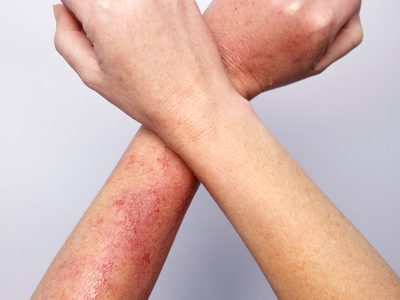Cozmoderm Clinic | Best Dermatology Clinic For Skin and Hair Care In Nagpur
Photodermatitis
Home / Photodermatitis

Photodermatitis
What are the symptoms?
The symptoms of phytophotodermatitis usually begin 24 hours after exposure and peak after 48–72 hours. The symptoms, which can be mild or severe, include:
- large areas of blistering
- itching
- redness or discoloration
- inflammation
- pain
- tenderness
- a burning sensation
- crusted patches of skin once the blisters have burst
The patches of blisters usually present in irregular shapes. The patterns represent the areas of the skin that became exposed to the chemical. For example, blisters in a drip pattern may result from exposure to fruit juice. Streaks may indicate that a person brushed their skin against a plant.
Causes
Phytophotodermatitis occurs when someone comes into contact with plant chemicals and then with sunlight. The symptoms typically arise after direct contact with the plant itself. Many plants and vegetables contain chemical compounds that cause sensitivity to sunlight. Such chemicals are known as photosensitizers. An example of a photosensitizer is a psoralen.
Some common plants that contain psoralen include:
- parsley
- carrot
- celery
- fig
- citrus fruits
- garden rue
- breadnut
- meadow grass
- parsnip
Psoralen may also be present in some fragrances and some plant oils, such as the oil of bergamot. On exposure to UVA light, psoralen causes photochemical reactions in the skin. These responses damage skin cells and cause cell death, leading to the symptoms of phytophotodermatitis.
Treatment
Most cases of phytophotodermatitis clear up with minimal intervention. However, treatment is available to reduce pain and shorten the duration of symptoms. Treatment options include:
- Avoiding reexposure: It is important to take steps to avoid the plant that caused the skin reaction. For many individuals, this may be enough to alleviate the symptoms.
- Avoiding other skin irritants: It may be helpful to wear cotton clothing and avoid the use of harsh detergents, soaps, and personal care products that may make the symptoms worse.
- Cold compresses: Placing a cool washcloth on the affected area provides relief.
- Topical creams: Applying soothing ointments, lotions, and creams to the skin may reduce swelling and itching.
- Corticosteroids: Topical steroidal creams will reduce inflammation and itching.
- Over-the-counter nonsteroidal anti-inflammatory drugs (NSAIDs): NSAIDs include aspirin and ibuprofen, and they may help reduce pain and swelling.
- Prescribed medications: A doctor may prescribe oral corticosteroids or antihistamines for severe symptoms.
- Reducing sun exposure: Spending less time in the sun, especially when UV rays are at their strongest, may help prevent hyperpigmentation from becoming even darker. Also, a person should always wear sunscreen when they cannot avoid sun exposure.
Risk factors
Phytophotodermatitis can affect anyone. However, several factors may increase a person’s risk of experiencing it.
The risk factors include:
- exposure to certain plants and plant-based products
- using perfumes or oils that contain particular plant chemicals
- sunny weather
- engaging in certain activities
